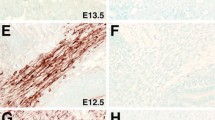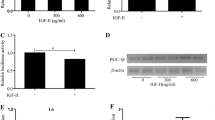Abstract
Fam210a is a novel protein regulating muscle mass and strength in mice in vivo. However, detailed effects of Fam210a on the function of myoblasts as well as modulators of Fam210a are still unknown. We, thus, investigated (1) the roles of Fam210a in myoblast differentiation, proliferation, apoptosis and degradation, and (2) the factors that regulate Fam210a expression in murine C2C12 cells. We found that the level of Fam210a mRNA was reduced during myoblast differentiation. Reduction in endogenous Fam210a levels by siRNA suppressed mRNA levels of myogenic factors (Pax7, Myf5, Myogenin, and Mhc) and a muscle degradation factor (Murf1). On the other hand, Fam210a siRNA did not affect mRNA encoding the apoptotic factors Bcl-2 and Bax and the extent of apoptosis as measured by ELISA in C2C12 cells. In contrast, Fam210a siRNA increased the mRNA level of Mmp-12, which induces osteoclastogenesis. Interestingly, insulin and 1,25(OH)2D, which are known to affect cell metabolism and muscle function, significantly increased the level of Fam210a mRNA in a dose-dependent manner. In addition, a PI3-kinase inhibitor and reduction in endogenous levels of the vitamin D receptor (VDR) by siRNA suppressed insulin- and 1,25(OH)2D-induced expression of Fam210a, respectively. In conclusion, Fam210a might enhance myoblast differentiation and proteolysis. Moreover, insulin and 1,25(OH)2D may induce myoblast differentiation and degradation by enhancing the expression of Fam210a.





Similar content being viewed by others
Abbreviations
- Mmp:
-
Metalloproteinase
- Pax:
-
Paired box protein
- Myf:
-
Myogenic factor
- Mhc:
-
Myosin heavy chain
- Murf:
-
Muscle RING finger
- Bcl:
-
B-cell lymphoma
- Bax:
-
Bcl-2-associated X protein
- 1,25(OH)2D:
-
1,25-Dihydroxy vitamin D3
- VDR:
-
Vitamin D receptor
References
Iannuzzi-Sucich M, Prestwood KM, Kenny AM (2002) Prevalence of sarcopenia and predictors of skeletal muscle mass in healthy, older men and women. J Gerontol A Biol Sci Med Sci 57(12):M772–777
Chien MY, Huang TY, Wu YT (2008) Prevalence of sarcopenia estimated using a bioelectrical impedance analysis prediction equation in community-dwelling elderly people in Taiwan. J Am Geriatr Soc 56(9):1710–1715
Cawthon PM, Marshall LM, Michael Y et al (2007) Frailty in older men: prevalence, progression, and relationship with mortality. J Am Geriatr Soc 55(8):1216–1223
Lauretani F, Russo CR, Bandinelli S et al (2003) Age-associated changes in skeletal muscles and their effect on mobility: an operational diagnosis of sarcopenia. J Appl Physiol 95(5):1851–1860
Haentjens P, Magaziner J, Colón-Emeric CS et al (2010) Meta-analysis: excess mortality after hip fracture among older women and men. Ann Intern Med. 152(6):380–390
Kawao N, Kaji H (2015) Interactions between muscle tissues and bone metabolism. J Cell Biochem 116(5):687–695
Estrada K, Styrkarsdottir U, Evangelou E et al (2012) Genome-wide meta-analysis identifies 56 bone mineral density loci and reveals 14 loci associated with risk of fracture. Nat Genet 44:491–501
Trajanoska K, Morris JA, Oei L et al (2018) Assessment of the genetic and clinical determinants of fracture risk: genome wide association and mendelian randomisation study. BMJ 362:k3225
Tanaka K, Xue Y, Nguyen-Yamamoto L et al (2018) FAM210A is a novel determinant of bone and muscle structure and strength. Proc Natl Acad Sci USA 115(16):E3759–E3768
Pedersen BK, Febbraio MA (2012) Muscles, exercise and obesity: skeletal muscle as a secretory organ. Nat Rev Endocrinol 8(8):457–465
Molinero A, Fernandez-Perez A, Mogas A et al (2017) Role of muscle IL-6 in gender-specific metabolism in mice. PLoS ONE 12(3):e0173675
Zimmers TA, Davies MV, Koniaris LG (2002) Induction of cachexia in mice by systemically administered myostatin. Science 296(5572):1486–1488
Boström P, Wu J, Jedrychowski MP et al (2012) A PGC1-α-dependent myokine that drives brown-fat-like development of white fat and thermogenesis. Nature 481(7382):463–468
Anastasilakis AD, Polyzos SA, Makras P et al (2014) Circulating irisin is associated with osteoporotic fractures in postmenopausal women with low bone mass but is not affected by either teriparatide or denosumab treatment for 3 months. Osteoporos Int 25(5):1633–1642
Tanaka K, Matsumoto E, Higashimaki Y et al (2012) Role of osteoglycin in the linkage between muscle and bone. J Biol Chem 287(15):11616–11628
Tanaka K, Kanazawa I, Kaji H et al (2017) Association of osteoglycin and FAM5C with bone turnover markers, bone mineral density, and vertebral fractures in postmenopausal women with type 2 diabetes mellitus. Bone 95:5–10
Snijder MB, van Schoor NM, Pluijm SM et al (2006) Vitamin D status in relation to one-year risk of recurrent falling in older men and women. J Clin Endocrinol Metab 91:2980–2985
Bischoff HA, Stahelin HB, Urscheler N et al (1999) Muscle strength in the elderly: its relation to vitamin D metabolites. Arch Phys Med Rehabil 80:54–58
Bischoff-Ferrari HA, Dawson-Hughes B, Willett WC et al (2004) Effect of Vitamin D on falls: a meta-analysis. JAMA 291:1999–2006
Bischoff-Ferrari HA, Dawson-Hughes B, Staehelin HB et al (2009) Fall prevention with supplemental and active forms of vitamin D: a meta-analysis of randomised controlled trials. BMJ 339:3692
Okuno H, Kishimoto KH, Hatori M et al (2012) 1a,25-dihydroxyvitamin D3 enhances fast-myosin heavy chain expression in differentiated C2C12 myoblasts. Cell Biol Int 36:441–447
Garcia LA, King KK, Ferrini MG et al (2011) 1,25(OH)2vitamin D3 stimulates myogenic differentiation by inhibiting cell proliferation and modulating the expression of promyogenic growth factors and myostatin in C2C12 skeletal muscle cells. Endocrinology 152:2976–2986
Asplund K (1975) Protein synthesis and amino acid accumulation during development in the rat: dissociation of diaphragm and heart muscle sensitivity to insulin. Horm Res 6(1):12–19
Bonadonna RC, Saccomani MP, Cobelli C et al (1993) Effect of insulin on system A amino acid transport in human skeletal muscle. J Clin Invest 91(2):514–521
Tanaka K, Kanazawa I, Sugimoto T (2015) Reduction in endogenous insulin secretion is a risk factor of sarcopenia in men with type 2 diabetes mellitus. Calcif Tissue Int 97(4):385–390
Horst D, Ustanina S, Sergi C et al (2006) Comparative expression analysis of Pax3 and Pax7 during mouse myogenesis. Int J Dev Biol 50(1):47–54
Soleimani VD, Punch VG, Kawabe Y et al (2012) Transcriptional dominance of Pax7 in adult myogenesis is due to high-affinity recognition of homeodomain motifs. Dev Cell 22(6):1208–1220
Weintraub H (1993) The MyoD family and myogenesis: redundancy, networks, and thresholds. Cell 75(7):1241–1244
Abe S, Rhee S, Iwanuma O (2009) Effect of mechanical stretching on expressions of muscle specific transcription factors MyoD, Myf-5, myogenin and MRF4 in proliferated myoblasts. Anat Histol Embryol 38(4):305–310
Cohen S, Nathan JA, Goldberg AL (2015) Muscle wasting in disease: molecular mechanisms and promising therapies. Nat Rev Drug Discov 14(1):58–74
Volpi E, Sheffield-Moore M, Rasmussen BB et al (2001) Basal muscle amino acid kinetics and protein synthesis in healthy young and older men. JAMA 286(10):1206–1212
Ueki K, Yamamoto-Honda R, Kaburagi Y et al (1998) Potential role of protein kinase B in insulin-induced glucose transport, glycogen synthesis, and protein synthesis. J Biol Chem 273(9):5315–5322
Buitrago C, Pardo VG, Boland R et al (2013) Role of VDR in 1α,25-dihydroxyvitamin D3-dependent non-genomic activation of MAPKs, Src and Akt in skeletal muscle cells. J Steroid Biochem Mol Biol 136:125–130
Tanaka M, Kishimoto KN, Okuno H et al (2014) Vitamin D receptor gene silencing effects on differentiation of myogenic cell lines. Muscle Nerve 49(5):700–708
Acknowledgements
This work was supported in part by Grants-in-Aid for Scientific Research (Early-Career Scientists: 18K16202), Academic research support from MSD Life Science Foundation.
Author information
Authors and Affiliations
Corresponding author
Ethics declarations
Conflict of interest
Ken-ichiro Tanaka, Ippei Kanazawa, J. Brent Richards, David Goltzman and Toshitsugu Sugimoto confirms that they have no conflict of interest.
Human and Animal Rights and Informed Consent
This article does not contain any studies with human participants or animals performed by any of the authors.
Additional information
Publisher's Note
Springer Nature remains neutral with regard to jurisdictional claims in published maps and institutional affiliations.
Rights and permissions
About this article
Cite this article
Tanaka, Ki., Kanazawa, I., Richards, J.B. et al. Modulators of Fam210a and Roles of Fam210a in the Function of Myoblasts. Calcif Tissue Int 106, 533–540 (2020). https://doi.org/10.1007/s00223-020-00661-y
Received:
Accepted:
Published:
Issue Date:
DOI: https://doi.org/10.1007/s00223-020-00661-y




